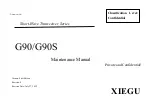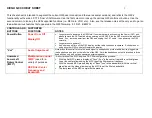
13
14
If the alarm still indicates a yellow blink with a single beep, the batteries may be depleted.
Replace them with fresh batteries.
If the red, yellow and green LEDs do not blink in sequence, the batteries may be installed
incorrectly (reverse polarity). Remove the alarm from the mounting bracket, remove the
battery cover and check if the batteries are installed correctly.
If the batteries were connected incorrectly, and after correcting the polarity of the batteries,
for the first hour, the alarm may indicate CO is present by a blinking red LED. Please note
that during this period, the alarm will still activate as required during an actual CO event.
Warning!
Exposures to high or low temperatures or high humidity may reduce battery life.
Use only batteries specified in marking. Use of a different battery may have a detrimental
effect on alarm operation.
Functional gas test
The alarm checks for CO gas every 4 seconds
and when exposed to the gas, the red LED will
blink to confirm that it is detecting the gas.
Solo C6 brand canned CO testing agent may
be used to verify the alarm’s ability to sense
CO. To gas test the alarm, spray the canned
CO within 1/4" of the gas entry holes for 3 s,
see
Overview
. Within seconds, the red LED
will begin to blink to confirm that the alarm
has detected the CO.
To return the unit to standby, simply leave
the alarm in clean air for a few minutes until
the red light is no longer blinking.
Figure 4
Battery replacement
What to do when the alarm sounds
Warning!
Actuation of your CO alarm indicates the presence of carbon monoxide (CO)
which can KILL YOU. If an alarm signal sound:
1
Operate reset/silence button (only operational at concentrations <250ppm).
2
Call your local fire department or 911.
3
Immediately move to fresh air, outdoors or by an open door/ window. Do a head count to en-
sure that all persons are accounted for. DO NOT re-enter the premises until the first responders
have arrived, the premises have been aired out and your alarm returns to its normal condition.
4
After following steps 1–3, if your alarm reactivates within a 24 hour period, repeat steps 1–3
and call a qualified appliance technician to investigate for sources of CO from fuel burning
equipment and appliances, and inspect for proper operation of this equipment. If problems
are identified during this inspection have the equipment serviced immediately. Note any
combustion equipment not inspected by the technician and consult the manufactures’
instructions, or contact the manufacturers directly, for more information about CO safety
and this equipment. Make sure that motor vehicles are not, and have not been, operating in
an attached garage or adjacent to the residence.
Note:
When ventilation is provided by leaving the window and doors open, the CO build up
may have dissipated by the time help arrives and the alarm may have stopped sounding.
Although your problem may appear temporarily solved, it is crucial that the source of the
CO is determined and appropriate repairs made.
How to protect your family
Follow these guidelines to reduce the risk of carbon monoxide poisoning.
1
Know and look out for warning signs that carbon monoxide may be present. These include:
The CO alarm warning of abnormal levels.
Staining, soot marks or discoloration on or around appliances.































